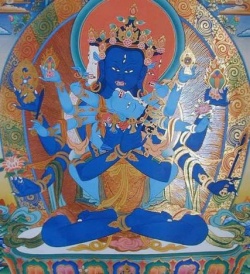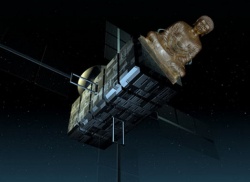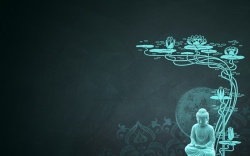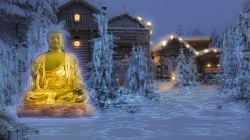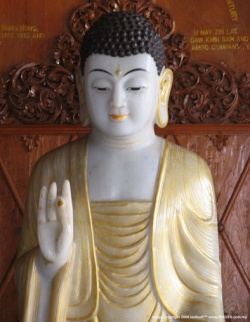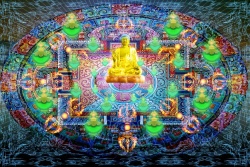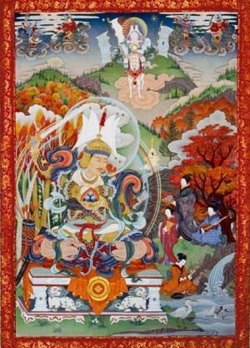The Meru Cosmos in Buddhist Art and Culture
In the traditional Buddhist model of the cosmos, Mt. Meru is the almost inconceivably immense mountain at the center of our world, so large that what we perceive as the blue of the sky is actually the blue stone (vaidūrya, lapis-lazuli or blue beryl, p. 51, n. 44) that makes up the side of the mountain facing us.
The idea of something so big that it is overlooked is a fine metaphor for the subject of cosmology in Buddhist studies, where the Meru cosmos, or cakravāla model, seems to be of marginal interest despite its ubiquity.
In this dissertation, an ambitious study in both scope and interdisciplinary approach, Eric Huntington demonstrates the centrality of the cakravāla model as a “a unifying theme” in Buddhist thought, practice and material culture, and describes how the model has been adapted to differing contexts, functions, and mediums of expression.
His methodology includes not only translation and interpretation of Buddhist texts, but also analysis of ritual and material culture and interviews with Buddhist ritual specialists and artists.
Chapter 1 acts as an introduction, and Huntington begins by noting the role that cosmology has played in many world traditions, addressing eternal, fundamental questions (What is the universe? Why are we here?).
However, in scholarship on Buddhism the subject has been either deemphasized or glossed over, often by pointing to descriptions of the cosmos detailed in the fourth-/fifth-century text, the Abhidharmakośa. Huntington attributes this neglect to the privileging by Western scholars of philosophical and scholastic aspects of Buddhism in an effort to “secularize” the religion, removing those elements that were antithetical to a contemporary scientific worldview (cosmological examples to which I would point include the flat earth and geocentric universe, long rendered historical curiosities).
However, this dissertation questions that view, and argues that the “style, iconography, and descriptions of various depictions of the Buddhist cosmos change in different contexts and traditions in ways that allow cosmological imagery (and textual description) to be contentful and expressive, rather than bound to a particular theorization” (p. 11).
In other words, he says, different versions of the cakravāla model were applied in differing contexts in the same way that different kinds of maps (topographical, weather radar, etc.) have value in particular circumstances.
Huntington identifies two such circumstances in which the Meru cosmos plays an integral part, but not necessarily as a description of the physical universe: deity maṇḍala and ritual offerings of the cosmos, both important elements of Esoteric Buddhist ritual practice.
These two contexts also allow the study to expand beyond the canonical texts and into other kinds of primary sources, such as architecture, ritual and ritual implements, and murals. Examples of these from Nepal and different Tibetan Buddhist regions make up the subjects of Chapters 3, 4 and 5, and the introduction goes on to outline these topics.
Early in Chapter 1 Huntington notes the influence of scholars who assert the centrality of cosmology to Buddhist studies (Stanley Jeyaraja Tambiah, Buddhism and the Spirit Cults in North-East Thailand. Cambridge Studies in Social Anthropology No. 2. Cambridge: Cambridge University Press, 1970; Rupert Gethin, “Meditation and Cosmology:
From the Aggañña Sutta to the Mahāyāna,” History of Religions 36, 1997; John Strong, The Legend of King Aśoka: A Study and Translation of the Aśokāvadāna. Princeton Library of Asian Translations.
Princeton: Princeton University Press, 1983; Stephen F. Teiser, Reinventing the Wheel: Paintings of Rebirth in Medieval Buddhist Temples. Seattle: University of Washington Press, 2006). He concludes the chapter with acknowledgement of other scholars whose work on Buddhist cosmology had some impact on his study (Randy Kloetzli, Buddhist Cosmology:
From Single World System to Pure Land. Delhi: Motilal Banarsidass, 1983; Adrian Snodgrass, Architecture, Time and Eternity: Studies in the Stellar and Temporal Symbolism of Traditional Buildings, ed. Lokesh Chandra, 2 vols. Śata-Piṭaka Series: Indo-Asian Literatures, New Delhi: Aditya Prakashan, 1990; Akira Sadakata and Hajime Nakamura, Buddhist Cosmology: Philosophy and Origins, trans. Gaynor Sekimori. Tokyo: Kosei Publishing Company, 2004; Martin Brauen, Mandala: Sacred Circle in Tibetan Buddhism. Stuttgart: Arnoldsche Art Publishers, 2009; Angela Falco Howard, The Imagery of the Cosmological Buddha. Leiden: E. J. Brill, 1986; Ferdinand Diederich Lessing, Yung-Ho-Kung: An Iconography of the Lamaist Cathedral in Peking, with Notes on Lamaist Mythology and Cult, vol. 1, Reports from the Scientific Expedition to the North-Western Provinces of China under the Leadership of Dr. Sven Hedin, the Sino-Swedish Expedition. Stockholm: Elanders Boktryckeri Aktiebolag, 1942).
Chapter 2 carefully balances a developmental overview of traditional Indian cosmological thought with select, detailed descriptions of the specific models, greatly aided by the very clear and well-produced plans and diagrams created by the author that appear throughout the dissertation. Before expanding into other areas in later chapters, Chapter 2 reviews the canonical and textual sources in order both to lay out in some detail the basic structural elements of the Meru cosmos and their evolution, and, by comparing and contrasting the models in different texts and traditions, to begin to suggest that the Meru model is less standardized than often assumed.
Although the Buddhist model is his focus, Huntington begins with the cosmos as described in Hindu Sources, the Vedas and Purāṇas, which share a basic sense of the world as discs or bowls of earth and sky linked by a central axial mountain, surrounded by either concentric rings of land or continents at the cardinal points. However, ambiguities in the specifics exist among and even within these early texts, a problem addressed by the Vāyu Purāṇa with forthright humility: “Only Brahmā knows it in full” (p. 32). Jain sources provide interesting differences in their models, such as multiple Merus and greater geographic detail, but also share many features with the concurrently developing Buddhist models.
Although Southern and Northern traditions of Buddhism later diverge in significant ways, early Pali Buddhist texts from the south such as the Visuddhimagga and the Lokapaññatti shared similar cosmological models with their northern contemporaries. The Pali texts, however, imply that the study of cosmology lacks the “practical” value of the study of ethics or meditation. After a brief overview of the models in these texts, Huntington turns to the north and devotes the rest of the chapter to a detailed accounting of the influential and much more detailed Meru models found in the Abhidharmakośa and later Kālacakra literature.
What emerges from Huntington’s detailed descriptions, diagrams and comparisons is the emergence of two complementary models from these sources whose ambiguities “open up a wide range of possibilities for Meru symbolism in a variety of cultural and ritual contexts” (p. 45); and an evolution from the Abhidharmakośa model towards a regular, systematic model in the Kālacakra, “whose very orderliness allowed for multiple, overlapping levels of symbolism” (p. 85). Some of the ramifications of this interpretive spectrum are presented in the next three chapters.
Chapters 3 and 4 detail the application of Meru symbolism in two adjacent Buddhist cultures: among the Newars of the Kathmandu Valley in Nepal; and in various Tibetan Buddhist regions of India and Tibet. Despite their reliance on similar textual sources, cosmology plays out very differently in the material and ritual cultures of these two Buddhist traditions. In Nepal, explicit cosmological symbolism requires some effort to discover and elucidate, whereas in Tibetan Buddhist areas it is clearly and frequently depicted in various contexts.
Chapter 3 examines the interrelationship in Newar Buddhism between the Meru cosmos, the Buddhist ur-monument—the stūpa (caitya in Nepal)—and the tantric maṇḍala. An example of such multilayered symbolism found in sites is presented in an exegesis of a modern caitya found at Bu Bahā in Patan, Nepal, which Huntington demonstrates can be understood on deeper and deeper levels, although by fewer and fewer people. He begins by noting the link, shared with all Nepalese caitya, to Kathmandu’s famed stūpa, Svayambhū Mahācaitya:
“First, at the most mundane, the caitya is a representation of Svayambhū, which arose as a luminous form atop a lotus in the mountain-ringed lake that was drained to become Kathmandu valley.”
Beyond this initial interpretation of the Bu Bahā caitya, we read, “[s]econd, at the level of the Vajradhātu that is governed by the five jina buddhas that appear both outside and within the caitya, the maṇḍala of the caitya is occurring in a jeweled pavilion atop the peak of Sumeru [[[Mt. Meru]]).
Third, at the level of the Buddha Vairocana who generates the Vajradhātu maṇḍala atop Meru, the location is none other than the highest heaven of the Sumeru system, Akaniṣṭha” (p. 106). The next half of the chapter is devoted to the use of Meru symbolism in the most common offering ritual in Newar Buddhism, a guru offering known as the guru-maṇḍala-arcana. Parallel to the architectural/monumental context of the caitya, the role of Meru as cosmos in the ritual is demonstrated to be multivalent, but more implied than explicit.
Chapter 4 turns to Tibetan Buddhist regions, in which the Meru cosmos appears, as it does in Nepal, in art, architecture and ritual, but much more frequently, unambiguously and in more varied forms than in Nepal. Here Huntington provides a wealth of description emphasizing the Meru cosmos as a recurring structural/organizing principle, first in deity maṇḍala, then in architecture.
However, the bulk of the chapter details Tibetan forms of the guru offering ritual, a central feature of which is the maṇḍala. In Tibetan Buddhist practice, he writes, “the maṇḍala offering…came to serve as a template for cosmic iconography used in everything from wall murals to sculptures to amulets…[it] becomes the symbol par excellence of guru devotion and tantric preliminary practices” (p. 160).
After discussing the ritual in great detail, Huntington concludes the chapter by asserting that “the image of Meru and the cakravāla system becomes the icon of more than the basic abhidharma cosmology;
it is the expansive symbol of the entire Buddhist world, including the fundamental principles of enlightenment. Furthermore, the role of the offering to the guru as one of the foundational and most often performed practices of Tibetan Buddhism provides the Meru imagery with a widespread platform from which to become popularized and influential” (pp. 203-204).
In Chapter 5, Huntington continues in the Tibetan Buddhist sphere, but expands his analysis, finding connections to the Meru cosmos more broadly. He applies many of the themes and principles covered in the previous chapters to link various examples of Tibetan Buddhist material culture to the iconography of the Meru cosmos, most of which he notes can be associated to greater or lesser degrees with offering rituals.
Although noting that possible examples are numerous, the first half of the chapter focuses on dough offerings (gTor ma); representations of “collections of adornments” (rGyan tshogs); protective amulets and “thread crosses” (mDos); “field of merit” paintings (tshogs zhing); and paintings portraying Meru as a vast altar. The second half of the chapter covers the familiar entrance murals found at most Tibetan Buddhist monasteries:
“The Wheel of Existence” (bhavacakra, Tib. srid pa’i ’khor lo) and an image of the Meru cosmos. Huntington discusses the significance of the two and their iconography in some detail, then compares a number of important in situ examples.
He concludes the chapter by noting the murals’ unusual status: despite their ubiquity, he argues, these murals are different from other Meru cosmos images in that they are not “cosmos as maṇḍala” or “cosmos as offering,” but rather are “explicitly didactic” (p. 271), liminal images bridging secular and sacred space that can be understood in part as demonstrating the importance of systematic, progressive explanation as a bridge to deeper understanding of the Tibetan Buddhist worldview.
Chapter 6 is a brief conclusion. Beginning with a review of key points of the dissertation, Huntington demonstrates the centrality of Meru symbolism in many facets of a Buddhist practitioner’s experience.
“From the moment of entering the monastery, to placing offerings on the altar, to showing devotion to the guru, to the conceptual location of buddhas within the cosmic hierarchy (as they appear in both meditations and the physical shrine rooms themselves), the cosmos and visions of the cosmos are among the most important visual metaphors and conceptual imagery that underlie the foundations of Buddhist practice.
Such cosmic principles are so ubiquitous that visitors and practitioners may sometimes not even realize what they are seeing—the Meru world-view is such a basic cultural assumption that it can become invisible” (p. 280).
He underpins his argument with the following: “Rather than see Buddhist cosmology as simply another layer of symbolism onto which Buddhist concepts can be mapped, we can learn to see it as the structuring principle, perhaps even the blueprint, from which the façade of Buddhism is constructed” (p. 284). He concludes the chapter by suggesting areas for future research in other Buddhist cultures, such as those of Japan or Thailand, and in other world systems within Buddhism, such as pure lands or Shambala.
In sum, Huntington’s study of the Meru cosmos succeeds admirably in its goals of bringing attention to the neglected field of traditional cosmology in Buddhist studies, and in being a model for the kind of interdisciplinary methodology that is appropriate to a topic of this dimension.
It is an important and welcome addition to a variety of fields, tying together Buddhist studies, literature, art history, and studies of ritual practice and material culture. It succeeds both as a “big picture” analysis of the underlying significance of the Meru cosmos in Buddhism generally (and particularly in Esoteric Buddhism), and also provides excellent detailed studies of ritual, murals, and other expressions that incorporate Meru symbolism.
Kevin R. E. Greenwood Allen Memorial Art Museum Oberlin College kevin.greenwood@oberlin.edu Primary Sources
Ethnographic fieldwork (interviews). Material culture (ritual objects, murals).Bhattacharyya, Benoytosh. Niṣpannayogāvalī of Mahāpaṇḍita Abhayākaragupta. Edited by Benoytosh Bhattacharya. Gaekwad’s Oriental Series. Baroda: Oriental Institute, 1949. Bajracharya, Naresh Man. Badrīratnakṛtaḥ Cāryagītiviśuddhisaṃgrahaḥ. Kathmandu, Nepal: Prem Kumārī Bajrācārya, 2003 (Newar Saṃvat 1123). Mi bskyod rdo rje. Chos mṅon pa’i mdzod kyi ’grel pa rgyas par spros pa grub bde’i dpyid ’jo. Vol. 1. New Delhi, 1975. Shastri, D., ed. Abhidharmakośa and Bhāṣya of Ācārya Vasubandhu with Sphuṭārthā Commentary of Ācārya Yaśomitra. 3 vols. Varanasi: Bauddha Bharati, 1970-72. Dissertation Information
University of Chicago. 2013. 410 pp. Primary Advisor: Gary Tubb.
